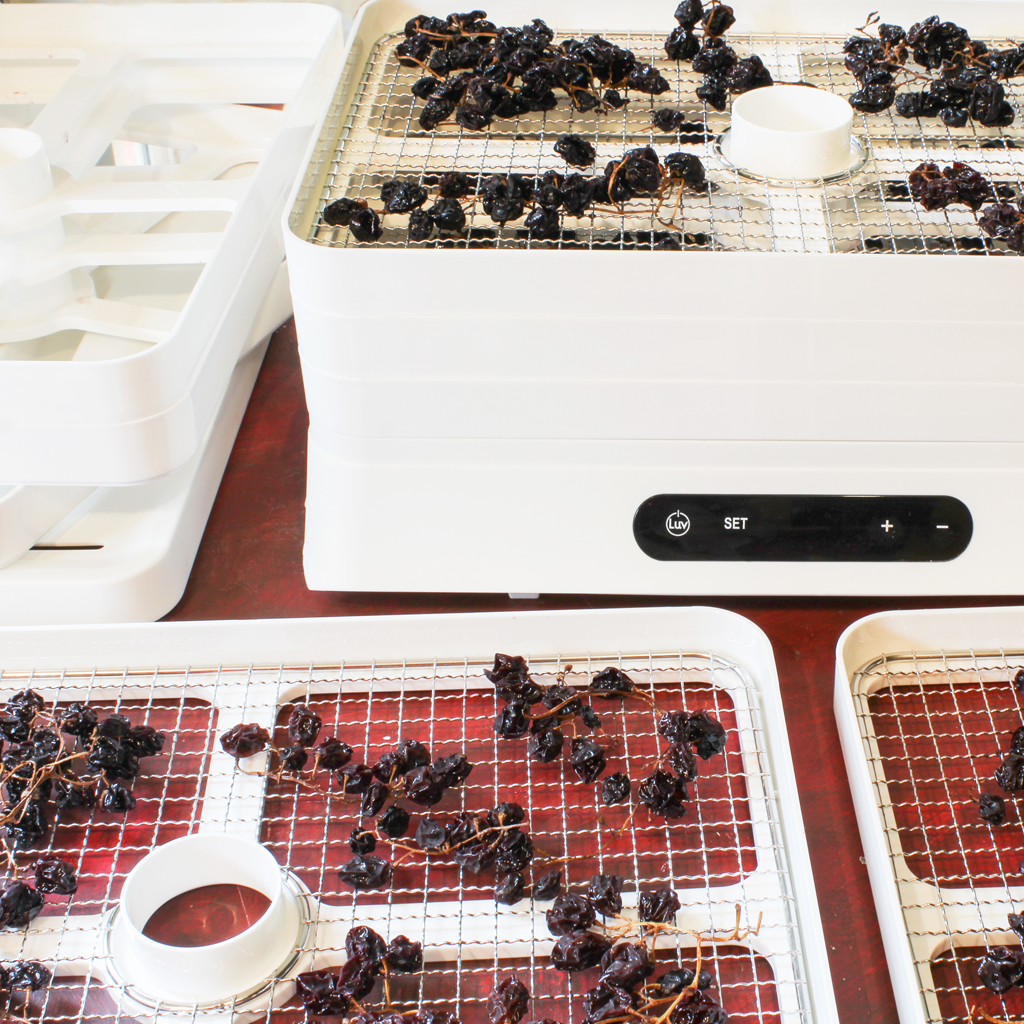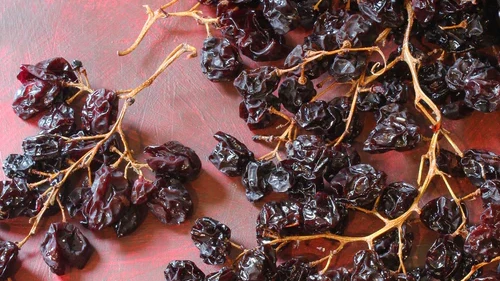Your Cart is Empty
FAST DISPATCH
FREE SHIPPING
FAST DISPATCH
FREE SHIPPING
FAST DISPATCH
FREE SHIPPING
Add description, images, menus and links to your mega menu
A column with no settings can be used as a spacer
Link to your collections, sales and even external links
Add up to five columns
Add description, images, menus and links to your mega menu
A column with no settings can be used as a spacer
Link to your collections, sales and even external links
Add up to five columns

Dehydrating muscatel grape clusters
Barb Hodgens
Barb Hodgens loves to cook with alternative, healthy whole food ingredients, with a focus on gut health. Barb has overcome her own gut health issues through healthy eating. Share your ideas, comments and photos at the end of this post :)

Delicious and decorative.
Muscatel grapes are well known for their distinctive, sweet and bold flavour, so we were very excited to sample them dried. We recently dehydrated two varieties of grapes to make homemade raisins and absolutely loved the results.
One of my favourite items on a cheeseboard are dried bunches of muscatel grapes. Dried grapes which are still attached to the stem or vine are fabulous decoration, and always elevate a platter to the next level! We just had to give it a try.
Many factors make dehydrating bunches of muscatel grapes difficult: they are large, there`s a lot of moisture, the skin is tough, and they are full of seeds. They are also super sweet. All of these things make the evaporation of their water content difficult.

The easiest way to dehydrate them would have been to remove the vine, slice them in half and remove the seeds with a spoon - but as we wanted to retain the integrity of the bunch, we had to get creative. Despite just having made raisins, we had to approach dehydrating clusters newly and break some dehydrating, best-practise rules in the process. Luckily the Breeze food dehydrator is a versatile unit.
Bunches of grapes are larger than the Breeze trays. To accommodate extra height and increase air flow we removed every second wire rack.
The skin on the grape needs to be broken to allow the moisture to escape for efficient drying. After a brief blanch to clean them, we scored each and every grape with a sharp knife. The process is a little tedious, but it probably takes around the same time as cutting grapes in half.
Drying grapes without breaking the skin, can lead to case hardening where the outside dries into a shell, and doesn't allow the moisture from the inside to escape. This can lead to moulding problems in storage and would be very disappointing.
You can remove the seeds as well. It’s additional work to scoop them out but it sure is worth the work. We left the seeds in several bunches to sample the results. Grape seeds give a slight crunch but aren’t so bothersome. In fact, grape seeds are actually loaded with nutritional value so there is no harm eating them.





Dehydrating muscatel grape clusters
Luvele
Rated 5.0 stars by 1 users
Muscatel grapes are well known for their distinctive, sweet and bold flavour, so we were very excited to sample them dried. We recently dehydrated two varieties of grapes to make homemade raisins and absolutely loved the results.
Ingredients
Muscatel grapes
Directions
- To wash the grapes and remove dust and insects, drop by the bunch into boiling water for 30 seconds, then transfer into a bowl of very cold or ice water.
Lay the grapes on a clean tea towel and thoroughly pat dry
With a sharp knife slice halfway throw each grape. Piercing is not sufficient; each grape really needs to be opened up as much as possible.
- Scoop out the seeds with your fingertips or a small spoon if you want but not essential.
Set the Breeze dehydrator trays up so that every second wire rack is removed, increasing the height.
Lay the bunches onto the trays. Air flow will be limited with larger bunches, so spread the bunches apart from one another.
- When you’re done, set the Breeze dehydrator to 60°C for 18 hours. The grapes may take several days to dehydrate.
The juice that spills from the cut grape is syrup-like and as the grapes dry it caramelises on the skins. To prevent sticking to the wracks, turn the bunches every eight hours or so. The stems become brittle so be gentle lifting them.
- To test for readiness, take a few samples from the trays and let cool completely. Homemade dried grapes will be a harder than store-bought ones, although they should have a little squish left inside of them, when they are ready. Some of the smaller grapes may be slightly crunchy from the sugars crystallising on the skin.
Dehydrated muscatel grapes can be stored in airtight containers for up to two years (or longer). Always use a jar with an airtight lid, or vacuum seal.
PIN THIS RECIPE

Dehydrating muscatel grape clusters

Delicious and decorative.
Muscatel grapes are well known for their distinctive, sweet and bold flavour, so we were very excited to sample them dried. We recently dehydrated two varieties of grapes to make homemade raisins and absolutely loved the results.
One of my favourite items on a cheeseboard are dried bunches of muscatel grapes. Dried grapes which are still attached to the stem or vine are fabulous decoration, and always elevate a platter to the next level! We just had to give it a try.
Many factors make dehydrating bunches of muscatel grapes difficult: they are large, there`s a lot of moisture, the skin is tough, and they are full of seeds. They are also super sweet. All of these things make the evaporation of their water content difficult.

The easiest way to dehydrate them would have been to remove the vine, slice them in half and remove the seeds with a spoon - but as we wanted to retain the integrity of the bunch, we had to get creative. Despite just having made raisins, we had to approach dehydrating clusters newly and break some dehydrating, best-practise rules in the process. Luckily the Breeze food dehydrator is a versatile unit.
Bunches of grapes are larger than the Breeze trays. To accommodate extra height and increase air flow we removed every second wire rack.
The skin on the grape needs to be broken to allow the moisture to escape for efficient drying. After a brief blanch to clean them, we scored each and every grape with a sharp knife. The process is a little tedious, but it probably takes around the same time as cutting grapes in half.
Drying grapes without breaking the skin, can lead to case hardening where the outside dries into a shell, and doesn't allow the moisture from the inside to escape. This can lead to moulding problems in storage and would be very disappointing.
You can remove the seeds as well. It’s additional work to scoop them out but it sure is worth the work. We left the seeds in several bunches to sample the results. Grape seeds give a slight crunch but aren’t so bothersome. In fact, grape seeds are actually loaded with nutritional value so there is no harm eating them.




PIN THIS RECIPE

Subscribe
Sign up to get the latest on sales, new releases and more …
